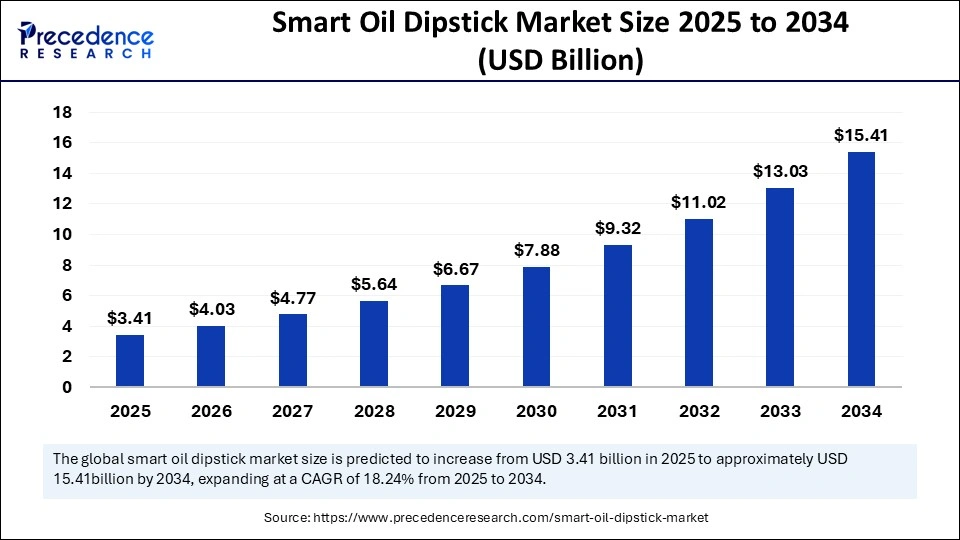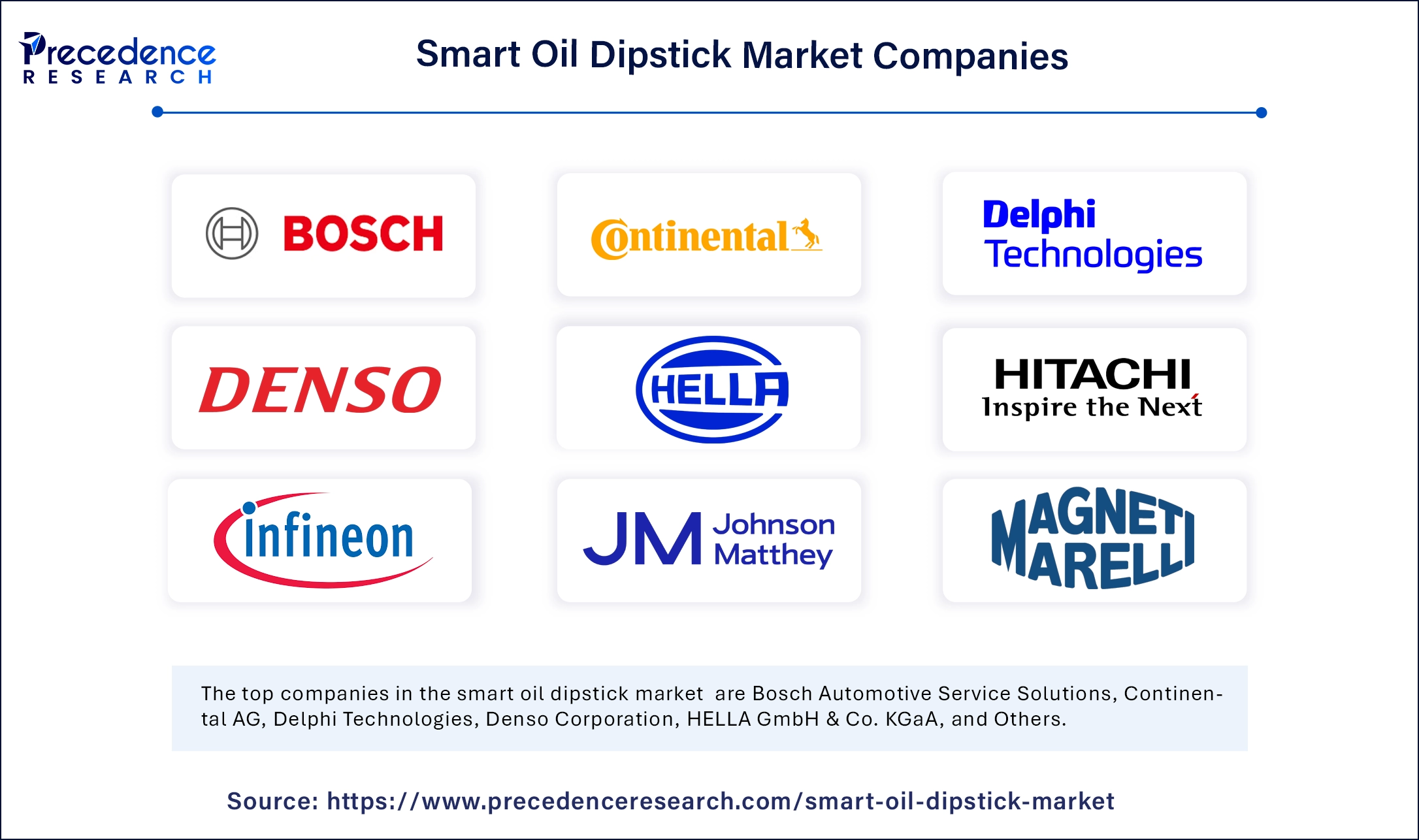The global smart oil dipstick market size was worth around USD 2.89 billion in 2024 and is expected to surpass around USD 15.41 billion by 2034 with a CAGR of 18.24%.

Smart Oil Dipstick Market Key Points
-
Asia Pacific dominated the smart oil dipstick market in 2024.
-
North America is expected to show the fastest growth during the forecast period.
-
By type, the anti-corrosion segment contributed the largest market share in 2024.
-
The steam jacket segment is projected to grow at a significant CAGR in the coming years.
-
By technology, the cellular segment led the market in 2024.
-
By application, the automotive segment held the biggest market share in 2024.
-
The industrial equipment segment is anticipated to witness rapid growth during the projection period.
-
By sales channel, the OEMs segment led the market in 2024.
-
The aftermarket segment is likely to grow at the fastest rate between 2025 and 2034.
What Is the Role of AI in the Smart Oil Dipstick Market?
Artificial Intelligence (AI) plays a transformative role in the Smart Oil Dipstick market by enhancing the accuracy and intelligence of engine oil monitoring systems. AI algorithms analyze real-time data from sensors embedded in the dipstick—such as oil level, viscosity, temperature, and contamination—to provide predictive insights into engine health. This allows vehicle owners and fleet managers to receive timely alerts and maintenance recommendations, helping to prevent engine failures and extend engine life.
Moreover, AI enables trend analysis and personalized diagnostics by learning from historical data and usage patterns. In connected vehicles, AI-integrated smart dipsticks can communicate with broader vehicle health monitoring systems, contributing to holistic and proactive maintenance strategies. This not only improves vehicle performance and reliability but also supports cost-saving through efficient maintenance planning, making AI a key driver of innovation in the smart oil dipstick market.
Smart Oil Dipsticks: Revolutionizing Real-Time Engine Oil Monitoring
A Smart Oil Dipstick is a digital automotive tool that uses embedded sensors to monitor engine oil level, quality, temperature, and viscosity in real-time. Unlike traditional dipsticks, it connects to the vehicle’s dashboard or a mobile app via Bluetooth or cellular networks, providing accurate and timely information. This enables users to receive alerts for low oil levels or oil degradation, improving engine performance and reducing the risk of breakdowns.
Smart oil dipsticks are gaining traction in both passenger and commercial vehicles due to their role in predictive maintenance. By analyzing data with the help of AI, these devices help optimize oil change intervals and extend engine life. Regions like Asia Pacific currently lead the market due to high vehicle production, while North America is expected to see rapid growth with rising adoption of smart vehicle technologies.
Market Overview: Enhancing Engine Maintenance through Smart Diagnostics
The Smart Oil Dipstick market represents an innovative leap in automotive and industrial engine maintenance technologies. Unlike traditional oil dipsticks, which provide a manual and often imprecise method of checking engine oil levels and quality, smart oil dipsticks are equipped with sensors and digital interfaces that deliver real-time, accurate data on oil condition, temperature, and contamination levels. This enables predictive maintenance, helping to prevent engine damage, reduce downtime, and optimize vehicle or machinery performance.
With the rising adoption of connected vehicles, IoT-enabled industrial equipment, and the increasing emphasis on preventive maintenance, smart oil dipsticks have gained significant traction across various sectors including automotive, marine, and heavy machinery. The market growth is fueled by the trend toward smarter, data-driven asset management and the need to extend engine life cycles while minimizing operational costs.
Get the Sample Copy of Report@ https://www.precedenceresearch.com/sample/6006
Growth Factors: Digitalization and Predictive Maintenance Trends
Several key factors are driving the growth of the smart oil dipstick market. The digital transformation sweeping through the automotive and industrial sectors plays a crucial role. As vehicles and machinery become more connected and equipped with onboard diagnostics, integrating smart oil dipsticks aligns with the broader trend of real-time monitoring and data analytics. Preventive and predictive maintenance strategies are becoming standard practice to reduce unexpected failures and costly repairs, especially in commercial fleets, manufacturing plants, and maritime applications.
Additionally, growing awareness about environmental regulations and the need to maintain engine efficiency are encouraging adoption. The development of wireless communication protocols and miniaturized sensors further supports the deployment of smart oil dipsticks, making the devices more accessible and easier to integrate into existing systems.
Market Scope
| Report Coverage | Details |
| Market Size by 2034 | USD 15.41 Billion |
| Market Size in 2025 | USD 3.41 Billion |
| Market Size in 2024 | USD 2.89 Billion |
| Market Growth Rate from 2025 to 2034 | CAGR of 18.24% |
| Dominated Region | Asia Pacific |
| Fastest Growing Market | North America |
| Base Year | 2024 |
| Forecast Period | 2025 to 2034 |
| Segments Covered | Type, Technology, Application, Sales Channel, and Regions |
| Regions Covered | North America, Europe, Asia-Pacific, Latin America and Middle East & Africa |
Market Dynamics
Key Market Drivers: Operational Efficiency and Cost Savings
The primary drivers behind the adoption of smart oil dipsticks include their ability to significantly enhance operational efficiency and lower maintenance costs. By providing accurate and continuous oil condition data, these devices allow fleet operators, manufacturers, and individual vehicle owners to perform maintenance only when necessary, thus avoiding premature oil changes and reducing waste. This contributes not only to cost savings but also to environmental sustainability by minimizing the disposal of used oil.
Furthermore, smart oil dipsticks help detect contamination, degradation, or leaks early, preventing severe engine damage and prolonging equipment lifespan. The increasing complexity of modern engines, particularly with the rise of hybrid and electric vehicles that still rely on oil for certain components, necessitates advanced monitoring solutions, making smart oil dipsticks increasingly relevant.
Opportunities: Integration with IoT and Fleet Management Systems
The market offers ample opportunities driven by the integration of smart oil dipsticks with IoT platforms and fleet management software. By combining oil condition data with GPS tracking, fuel consumption metrics, and driver behavior analytics, fleet operators can gain a comprehensive view of vehicle health and optimize maintenance schedules more effectively. The emergence of Industry 4.0 in manufacturing also opens doors for smart oil dipsticks in heavy machinery and industrial engines, where downtime can result in significant financial losses.
Another promising area is the aftermarket segment, where retrofit smart dipsticks for older vehicles and equipment represent a large untapped market. Additionally, collaborations between sensor manufacturers, software developers, and OEMs are fostering innovation in multifunctional devices that monitor a variety of engine parameters beyond just oil condition.
Challenges: Technology Adoption and Cost Constraints
Despite promising growth, the smart oil dipstick market faces challenges that could slow adoption. The initial cost of smart dipstick devices and the associated integration with digital platforms may deter smaller fleet operators or individual consumers, particularly in price-sensitive markets. Concerns about device durability and sensor accuracy in harsh engine environments also pose technical challenges.
The need for standardized communication protocols and interoperability among different vehicle and equipment brands can complicate large-scale deployments. Furthermore, the automotive aftermarket remains fragmented, and convincing users to upgrade from traditional dipsticks requires sustained education and demonstration of clear ROI. Data security and privacy concerns related to IoT connectivity add another layer of complexity for widespread acceptance.
Smart Oil Dipstick Market Companies

- Bosch Automotive Service Solutions
- Continental AG
- Delphi Technologies
- Denso Corporation
- HELLA GmbH & Co. KGaA
- Hitachi Automotive Systems
- Infineon Technologies AG
- Johnson Matthey
- Magneti Marelli S.p.A
- NGK Spark Plug Co., Ltd.
- NXP Semiconductors N.V.
- Robert Bosch GmbH
- Sensata Technologies
- STMicroelectronics
- TE Connectivity
- Texas Instruments Incorporated
- Valeo S.A.
- ZF Friedrichshafen AG
- Analog Devices, Inc.
- Aptiv PLC
Recent Development
- In November 2023, Hero MotoCorp Ltd. announced a collaboration with an Indian startup. This collaboration will pioneer development as well as affordability of the smart oil dipsticks that are customized for motorcycles.
Segments Covered in the Report
By Type
- Anti-corrosion
- Steam Jacket
By Technology
- Bluetooth
- Wi-Fi
- Cellular
By Application
- Automotive
- Industrial Equipment
- Marine
- Aerospace
- Others
By Sales Channel
- OEMs
- Aftermarket
By Region
- North America
- Europe
- Asia Pacific
- Middle East & Africa
- Latin America
Read More: Passenger Vehicle ADAS Market